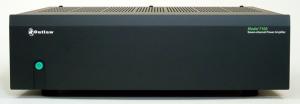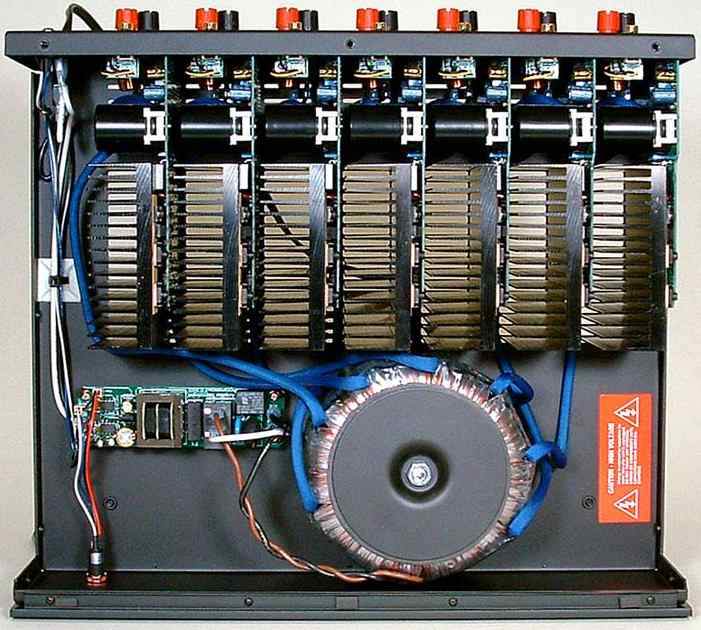TITLE

Specifications:
-
Power Output (FTC): 7 x 100
watts @ 8 ohms, 20 -
20kHz, 0.05% THD, All Channels Driven;
7 x 165 watts @ 4 ohms, 20 - 20kHz, 0.05% THD,
All Channels Driven
- Signal to Noise: 119dB "A" weighted
- MFR: 20Hz. -20kHz. +/- 0.1 dB at
rated output
- THD: < 0.05% at rated output, all
frequencies,
<0.01% at 1 kHz.
- IMD: < 0.05% at rated output.
- Power Bandwidth: 5Hz - >100 kHz
+0/-3 dB
- Damping Factor: > 400 from 10 Hz to
400 Hz
- Crosstalk: > -90 dB from 20 Hz to
20Khz
- Gain: Voltage gain of 28.
- Slew Rate: 50v/Microsecond
- Input Impedance: Nominal 50
kOhms
- Size: (HxWxD): 5" with feet x 17.2"
x 16.2"
- Weight: 51 Pounds
- MSRP: $899 USA
Outlaw Audio
Introduction
I often get more excited by a high quality product at a low price than a price-no-object statement piece, no matter how divine the performance. Outlaw Audio�s model 7100 seven channel amplifier sells for $899 plus shipping, and represents a solid value.
Outlaw sells products direct to
consumers over the Internet, cutting out the retailer and everything that
goes along with retailers: rent, staffing, and profit margin. Of course you
also have to give up the
ability to try out the product in the store and getting the salesperson�s advice.
Instead of auditioning the equipment in the store, Outlaw offers you a 30
day home trial. Instead of a salesperson�s advice, Outlaw offers a (mostly
uncensored) Internet forum.
Outlaw and their business model aren�t news to Secrets readers, as we�ve
reviewed Outlaw�s 200 watt per channel monoblock amplifiers and a 90 pound,
seven-channel x 200 watts beast. While reasonably priced by any
measure – by the pound, by the watt, by the dollar – those amps are clearly
aimed at folks who need lots of power (the seven-channel x 200 amp requires its own
electrical circuit) and are comfortable with separates. The 7100 offers
100 watts per channel, and seems to be aimed at people looking to
upgrade from receivers to separates, but who don't want to have it delivered
with a forklift. It�s therefore quite reasonable to ask, "Are 100 watts per channel enough?"
It�s important to distinguish between dedicated amplifier specs and a
receiver�s amplifier specs. Low end receivers sometimes use amps-on-a-chip,
not discrete amplifiers. They typically only reach their rated power
output at certain frequencies, and either have high distortion rates or use
lots of negative feedback. Even many higher end receivers are rated only for
8 or 6 ohm loads. And even those receivers that honestly put out the juice
are sharing a power supply with processing and switching circuitry.
The Design
The Outlaw 7100 weighs 51 pounds, and is spec�d at 7 x 100 watts @ 8 ohms, 20 - 20kHz, 0.05% THD, all channels driven, or 7 x 165 watts @ 4 ohms, 20 - 20kHz, 0.05% THD, all channels driven. Nothing extraordinary here (beyond the price), but good solid numbers nonetheless.

Designed
and built in the United States, the Model 7100 uses a modular design you can
clearly see through the chassis vents. Each channel has four discrete output
devices and 20,000 microfarads of filter capacitance. So, for seven
channels, that's 140,000 �F total, which is a big number in anyone's book. The unit's high
current power supply is driven by a 1.2 kVA toroidal transformer with separate windings for each channel.
Individual heatsinks provide cooling for each amplifier module. No fans
are needed for cooling, so in operation the amp makes no mechanical noise of
its own. In addition, the amplifier is protected against high heat and
over-current conditions by separate protection circuits for each channel.
A low-voltage trigger input is provided to integrate with the pre/pro that supports it, and it worked as advertised with Outlaw's Model 950 pre/pro. I simply left the amp on all the time when paired with my Yamaha DSP-A1 receiver, using the pre-outs to drive it.

The Sound
I got a
chance to
compare the 7100 back to back with another similarly priced amplifier. This isn�t
part of my normal test suite, just bad luck. As I was hooking it up to
my system I discovered that my 300 watt Carver Lightstar amplifier driving
my dual subwoofers died. Replacing the fuse had no effect, so I tried
powering the subs – just the subs – using a Harman Kardon PA-5800 amp I have
on hand. The PA-5800 is rated to deliver 110 watts per channel into 4 ohms.
That�s less than the 150 watts per channel they were used to getting, but I
figured as long as I don�t need that last half decibel of volume, I should
be fine.
It didn�t work out that way. All my speakers, including the subs, are part
of the Carver 5.2HT series and are listed as 4 ohms. The PA-5800 is a five
channel amp that originally sold in the $1,000 range. I�d been using it to
power the surround and front effects channels from my Yamaha DSP-A1 / Parasound CSE 6.1 combo and was quite pleased with the breathing room it
gave the receiver. But when I used it for the subwoofers (and powered the
rest of the speakers with the Outlaw 7100), bass was muddy, resonant, and
ill defined. The PA-5800 lacked the power and control the subs needed – and
this was not a subtle audiophile thing. Bass guitars sounded fuzzy, and
movie explosions were loud, but not distinct.
Next, I connected just the rear center channel to the PA-5800, and drove all
five main speakers plus the two subwoofers with the 7100. And it rocked. I
don�t usually get excited by amplifiers. They take a signal and make it
louder. Sonic differences between them tend to be subtle. But I do get
excited by value: when the Outlaws tell you that for $899 they�ll give you
165 watts per channel (into 4 Ohms), for all seven channels, all driven hard
at the same time, you can believe them.
What impressed me most was the bass. I ran through my usual test suite of
music and movie clips, and the 7100�s bass was tighter and more tuneful for
both movies and film than either the Harman Kardon or the Carver Lightstar
(though, to be fair, the Carver may have been sick before it died).
Music
Dave
Matthews Band�s CD Crash – Track 1, "So Much To Say" has a rolling bass line
and a lot of jam-style instrumentation. It played loud and clear. My only
criticism: there was a tiny bit of congestion in the instrument mix at high
volumes. I ran through tracks from several CDs, and in both DPL-II and stereo,
the amp�s tone was neutral leaning towards analytic; for a strictly two
channel setup I would prefer a bit more warmth. Not a criticism, just my
preference for sound characteristics.
I was not able to test DVD-A or SACD, so I started with a DTS DVD – Diana
Krall, Live in Paris. Track 6: ��Deed I do� is a great test of low level
detail resolution – I�m still not 100% sure what the humming sound is at
38:04. The music had plenty of swing, and I had no complaints. Moving on to a
Dolby Digital DVD, I listened to James Taylor Live at the Beacon Theater. I
intended to listen to �Me and My Guitar� and then move on, but in the end I
listened to a half dozen tracks without writing any notes. Always a good
sign.
Movies
People considering a seven channel amplifier are probably most interested in
using it for home theater. This was where the 7100 distinguished itself.
Here are a few highlights:
The pod race sequence in Star Wars Episode 1 is basically a Dolby Digital EX
test track. Deep, deep bass on the explosions, exquisite sound design on the
flybys/overs, distinctive engine sounds, layered music, and occasional
dialogue. The 7100 provided a completely immersive soundfield, with all the
different harmonics from each of the pods� engines. Driving five speakers
and two subwoofers, the 7100 kept its composure at all volume levels, even
with the pre/pro set to produce regular peaks at over 95 dB measured at the
sitting position. You want to go louder than that? I don�t – I need my
hearing to do this job.
I moved on to The Matrix, and watched several loud scenes to hear if the
sounds of ejected shell casings are distinct within the mix. They were.
Chapter 31 includes helicopter flyovers that test your surround integration
and how loud can they play, and more fun with shell casings. Are they
distinct throughout the shootout, or just when the camera looks up at the Gatling gun, and at that point, are they harsh? The 7100 passed with flying
colors.
Impressed with how loud it could play and the �tunefulness� of the bass, I
moved on to dialogue intelligibility. The ideal test here is where the
actors are recorded on set, not dubbed afterwards in a studio. To make it
difficult, add in slurring and bad accents, and you�ve got: This is Spinal
Tap. The outside interview scenes (ex: �Dust For Vomit�) and guitar storage
scene (�This one goes to eleven�), meet all these requirements, and, unlike
the action demo sequences, are enjoyable even when watched repeatedly. This
is more of a test of the processor and speakers than the amplifier, but the
7100 was not the weak link.
Conclusions
Inigo
Montoya said in The Princess Bride, "Let me explain. No, there is too much."
So, let me sum up on the Outlaw 7100. It is quite good but slightly
analytical for two
channel music. However, it is a terrific performer across the board with home theater,
with more than enough power for anything I threw at it. At $899 for all
seven channels, it is unquestionably
a tremendous bargain.
- Avi Greengart -

